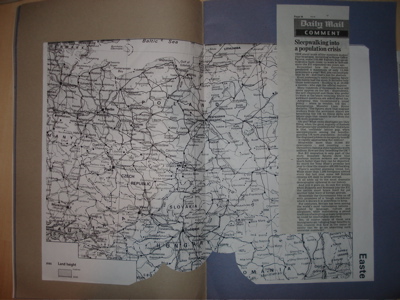Borderlines
Sophie contributed to discussion at Borderlines, Athens
Reunion - News from Nowhere
The expansion of the European Union in May 2003 to include 10 former
socialist states caused wide spread media attention in the UK. News
of the accession of Bulgaria and Romania in January 2007 has been met
with the introduction of even more stringent immigration laws. Much
of the press coverage in the UK over the widening of the European
Union has been xenophobic, based on misunderstandings of other
cultures and a fear of invasion of foreign workers. Headlines such as
‘Migrants ruining lives’ and ‘Migrants out of control’ continue to
reflect these views, where as now, they are on the same page as
travel tips to Dubrovnik and Ljubljana. Such double standards have
been normalised and are reflected in Britain’s changing policies on
immigration and human rights. The progression of Europe towards
economic unification is resulting in incidents of rising nationalism.
The diverse ways in which artists are experiencing and interpreting
the issues of a widening Europe was the subject of Trading Places, an
exhibition curated by B+B (Sarah Carrington and Sophie Hope) in May
2003 in London (www.welcomebb.org.uk). The work in the exhibition and
the integral programme of events presented different approaches
artists based in Central and South Eastern Europe are taking towards
issues of migration and border-crossing, from representing the
experiences of migration as migrants themselves or collaborating with
migrants to co-produce narratives, through to direct action by
presenting alternatives to overcoming borders. The participants of
Trading Places shared the need to raise the debate about migration
and create a more complex picture that could challenge the dominant
simplistic, imperial notion of nationalism. It became apparent,
through working on Trading Places, that the concern that artists and
curators have for reflecting and perhaps effecting change in the
current social and political climate is inseparable from the power-
plays inherent in the artist’s role as story-teller, educator,
activator and agitator. The works and discussions in Trading Places
raised the question: what is the relationship between the artist and
her politics; how is a critique of that context and politics formed,
performed, shared and made manifest?
Reunion is a framework through which to continue investigating this
question. As a continuation of Trading Places, Reunion, led by Sophie
Hope, is an action research, contemporary visual arts project that
consists of meetings, experiments, residencies and exhibitions
involving artists and curators based in the UK and South East Europe.
The aim is to try out ideas and reflect on what it means to be
political as a cultural producer in Europe today. The focus on this
geographical area stems from a need to challenge perceptions of the
‘new’ Europe and its borders and to bring questions of unification,
nationalism and identity to the fore. The Reunion projects have been
a process of reviewing differences, commonalities and frictions
across Europe.
Each research trip for the participants of Reunion - the meetings
over coffee, train journeys and experiments in a strange land - are
impossible attempts at trying to understand ones relation to a place.
Who gets to report on these research trips? How is the communication
across borders reciprocal and not just one way? Through Reunion,
artists are moving from ‘east’ to ‘west’ and ‘west’ to ‘east’ to
decide for themselves who and what gets interpreted, understood and
reported.

